A container of volume made of a perfectly non conducting material is divided into two equal parts by a fixed rigid wall whose lower half is non conducting and upper half is purely conducting. The right side of the wall is divided into equal parts initially by means of a massless non conducting piston free to move as shown . Section constains of a gas while the section and contain each of the same gas at pressure . The heater in left part is switched on till the final pressure in section becomes . Calculate
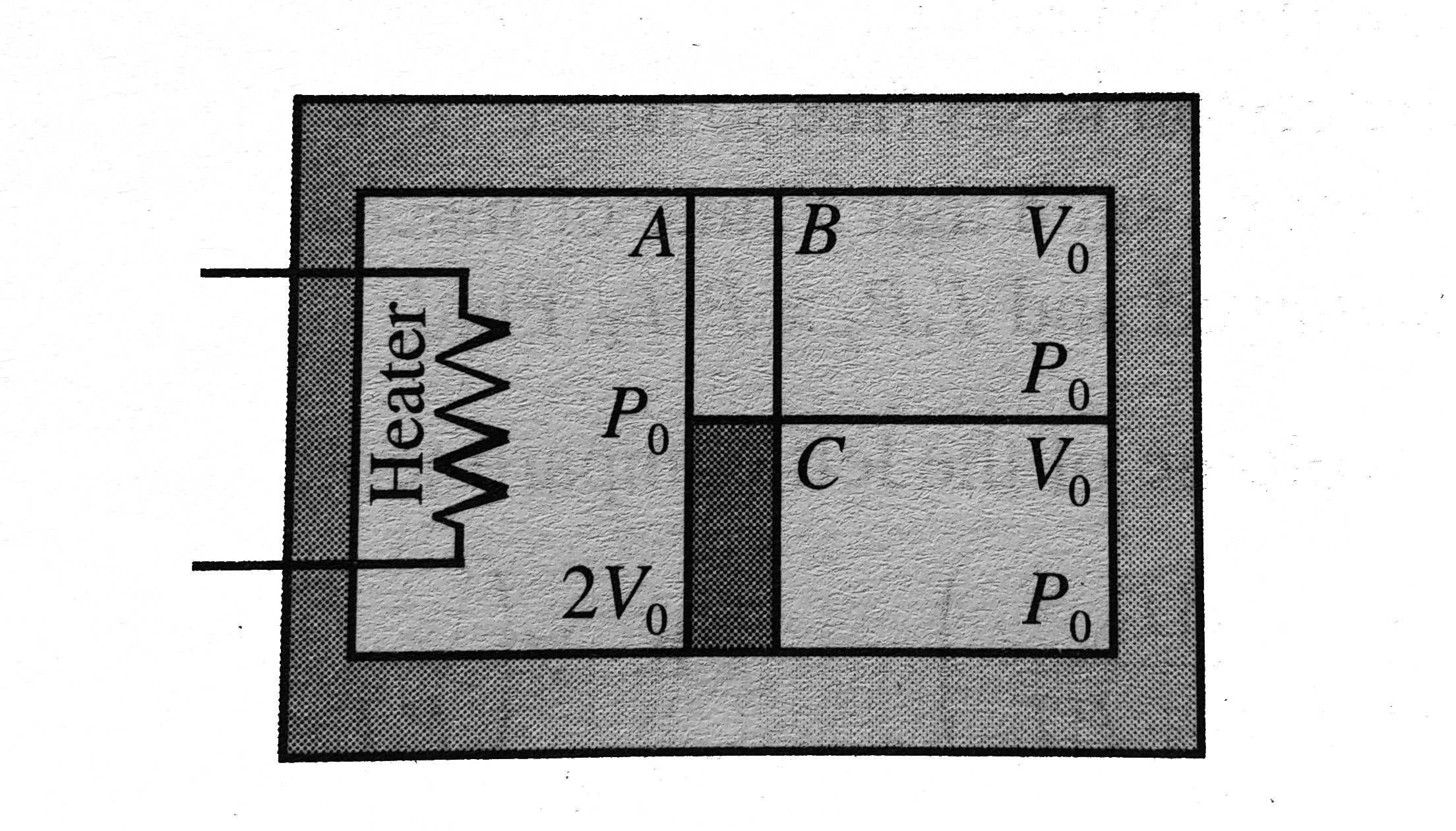
Find the temprature in part C
The correct Answer is:D
As for any process,
Topper's Solved these Questions
- BOOK - VMC MODULES ENGLISHCHAPTER - GASEOUS STATE & THERMODYNAMICSEXERCISE - JEE MAIN (ARCHIVE )81videos
GASEOUS STATE & THERMODYNAMICS
- BOOK - VMC MODULES ENGLISHCHAPTER - GASEOUS STATE & THERMODYNAMICSEXERCISE - JEE ADVANCED (ARCHIVE )111videos
GASEOUS STATE & THERMODYNAMICS
- BOOK - VMC MODULES ENGLISHCHAPTER - GASEOUS STATE & THERMODYNAMICSEXERCISE - Level - 175videos
GASEOUS STATE & THERMODYNAMICS
- BOOK - VMC MODULES ENGLISHCHAPTER - ENERGY & MOMENTUMEXERCISE - JEE ADVANCE (ARCHIVE) - TRUE/FALSE TYPE1videos
ENERGY & MOMENTUM
- BOOK - VMC MODULES ENGLISHCHAPTER - GRAVITATIONEXERCISE - JEE Advance (Archive) TRUE/FALSE1videos
GRAVITATION
Similar Questions
Explain why a Carnot engine cannot have 100% efficiency?
07:33View SolutionAn ideal gas is taken around the cycle ABCDA as shown in the P-V diagram. What is the work done during the cycle?
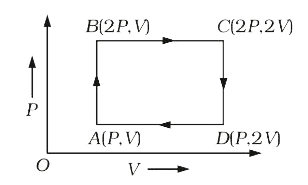 07:33View Solution
07:33View SolutionFour particles have velocities 1,0,2,and3m/s. The root mean square velocity of the particles (definition wise) is.
07:33View SolutionTwo particles of mass 1 kg and 3 kg move towards each other under their mutual force of attraction. No other force acts on them. When the relative velocity of approach of the two particles is 2m/s, their centre of mass has a velocity of 0.5 m/s. When the relative velocity of approach becomes 3m/s, the velocity of the centre of mass is 0.75 m/s.
09:12View SolutionIs it possible to put an artificial satellite in an orbit in such a way that it always remain visible directly over New Delhi ?
05:10View SolutionA container of volume 4V_(0) made of a perfectly non - conducting material is divided into two equal parts by a fixed rigid wall whose lower half is non - conducting and upper half is purely conducting. The right side of the wall is divided into equal parts ( initially 0 by means of a massless non - conducting piston free to move as shown . Section A constains 2 mol of a gas while the section B and C contain 1 mol each of the same gas ( gamma = 15. ) at pressure P_(0) . The heater in left part is switched on till the final pressure in section C becomes 125//27 P_(0) . Calculate Final temperature in part A .
08:26View SolutionA container of volume 4V0 made of a perfectly non− conducting material is divided into two equal parts by a fixed rigid wall whose lower half is non− conducting and upper half is purely conducting. The right side of the wall is divided into equal parts ( initially 0 by means of a massless non− conducting piston free to move as shown . SectionA constains 2mol of a gas while the section B and C contain 1mol each of the same gas (γ=15.) at pressure P0 . The heater in left part is switched on till the final pressure in section C becomes 125/27P0. Calculate
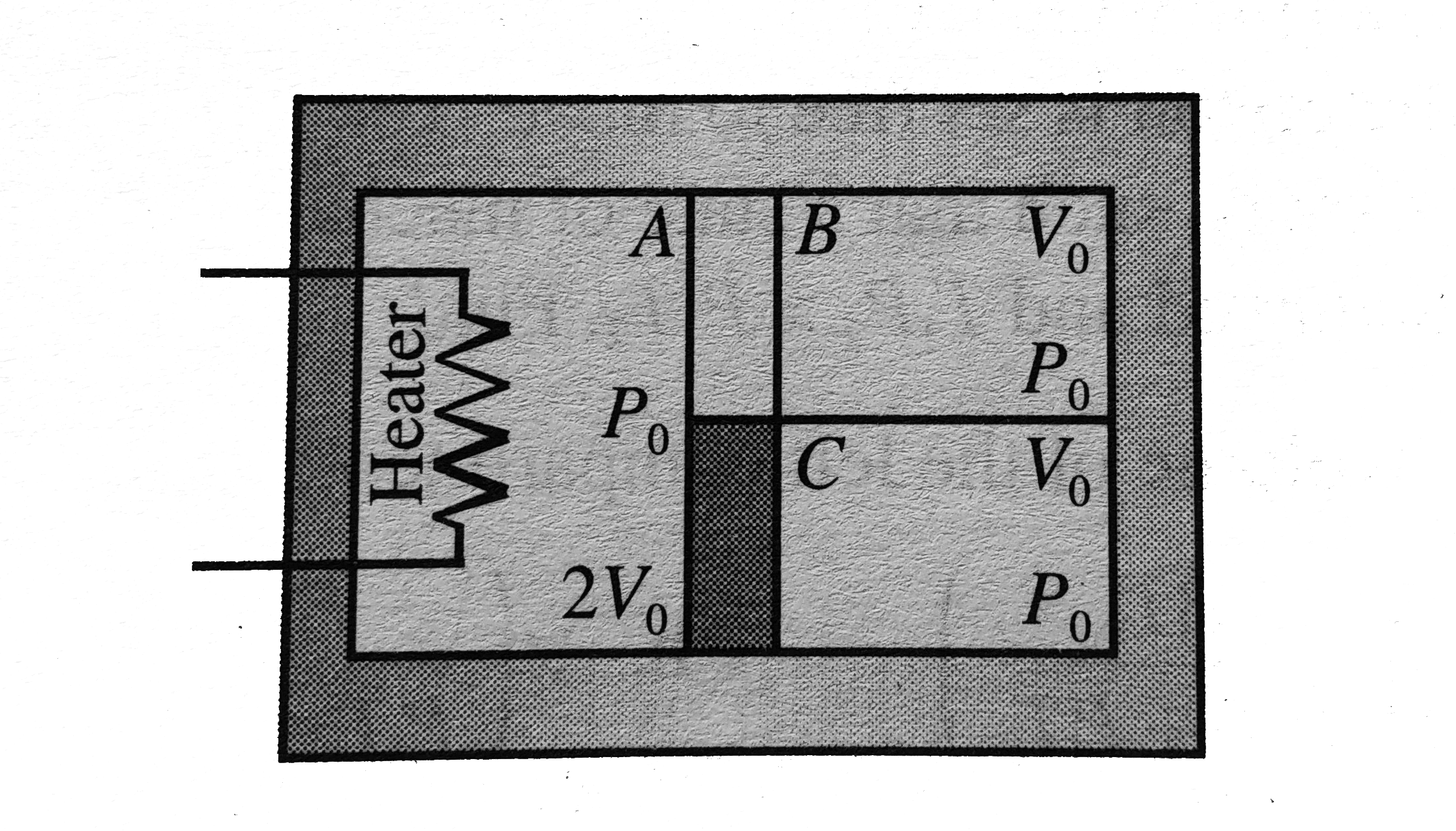
Final temperature in part C.07:43View SolutionA container of volume 4V0 made of a perfectly non− conducting material is divided into two equal parts by a fixed rigid wall whose lower half is non− conducting and upper half is purely conducting. The right side of the wall is divided into equal parts ( initially 0 by means of a massless non− conducting piston free to move as shown . Section A contains 2mol of a gas while the section B and C contain 1mol each of the same gas (γ=15.) at pressure P0 . The heater in left part is switched on till the final pressure in section C becomes 125/27P0. Calculate

The heat supplied by the heater.05:43View SolutionComprehension-2
A mono atomic ideal gas is filled in a non conducting container. The gas can be compressed by a movable non conducting piston. The gas is compressed slowly to 12.5% of its initial volume.
The percentage increases in the temperature of the gas is01:54View SolutionA cylinder contains equal volumes of Ar and H2, separated by a freely movable piston B. Piston A can also move without friction. Volume of each gas in equilibrium isV0. All walls of the container including piston A are non conducting.
(i) Piston A is pushed down slowly till the volume occupied by argon becomes V04 . Find the volume of H2. Assume that piston B is also non conducting.
(ii) Now assume that piston B is conducting and assume that each gas has n moles. The external agent performs work W0 in slowly pushing down the piston A. Find rise in temperature of each gas.
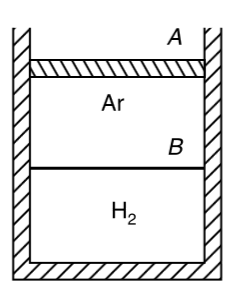 04:34View Solution
04:34View SolutionA cylindrical adiabatic container of total volume 2V0 divided into two equal parts by a conducting piston which is free to move as shown in figure. Each part containing identical gas at pressure P0. Initially temperature of left and right part is 4T0andT0 respectively. An external force is applied on the piston of area 'A' to keep the piston at rest. The value of external force required when thermal equilibrium is reached is.
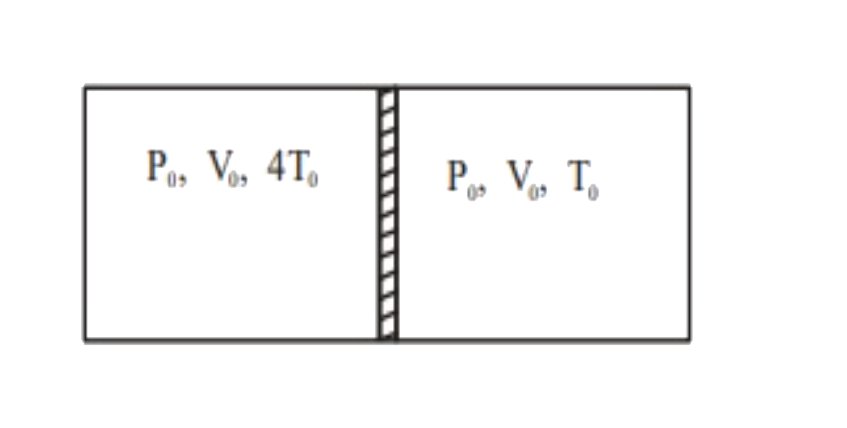 10:22View Solution
10:22View SolutionA non - conducting piston of mass m and are S0 divides a non - conducting, closed cylinder as shown in the figure. A piston having mass m is connected with the top wall of the cylinder by a spring of force constant k. The top part is evacuated and the bottom part is evacuated and the bottom part contains an ideal gas at a pressure P0 in the equilibrium position. Adiabatic exponent γ and in equilibrium length of each part is l. (neglect friction). Find the angular frequency for small oscillation.
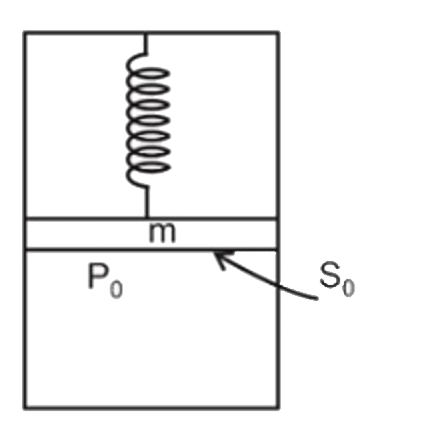 10:13View Solution
10:13View SolutionA cylindrical container having non-conducting walls is partitioned in two equal parts such that the volume of the each parts is eqaul to V0 A movable non-conducting piston is kept between the two parts. Gas on left is slowly heated so that the gas on right is compressed upto volume V0/8. Find pressure and temperature on both sides if initial pressure and temperature, were P0 and T0 respectively. Also find heat given by the heater to the gas (number of moles in each parts is n)
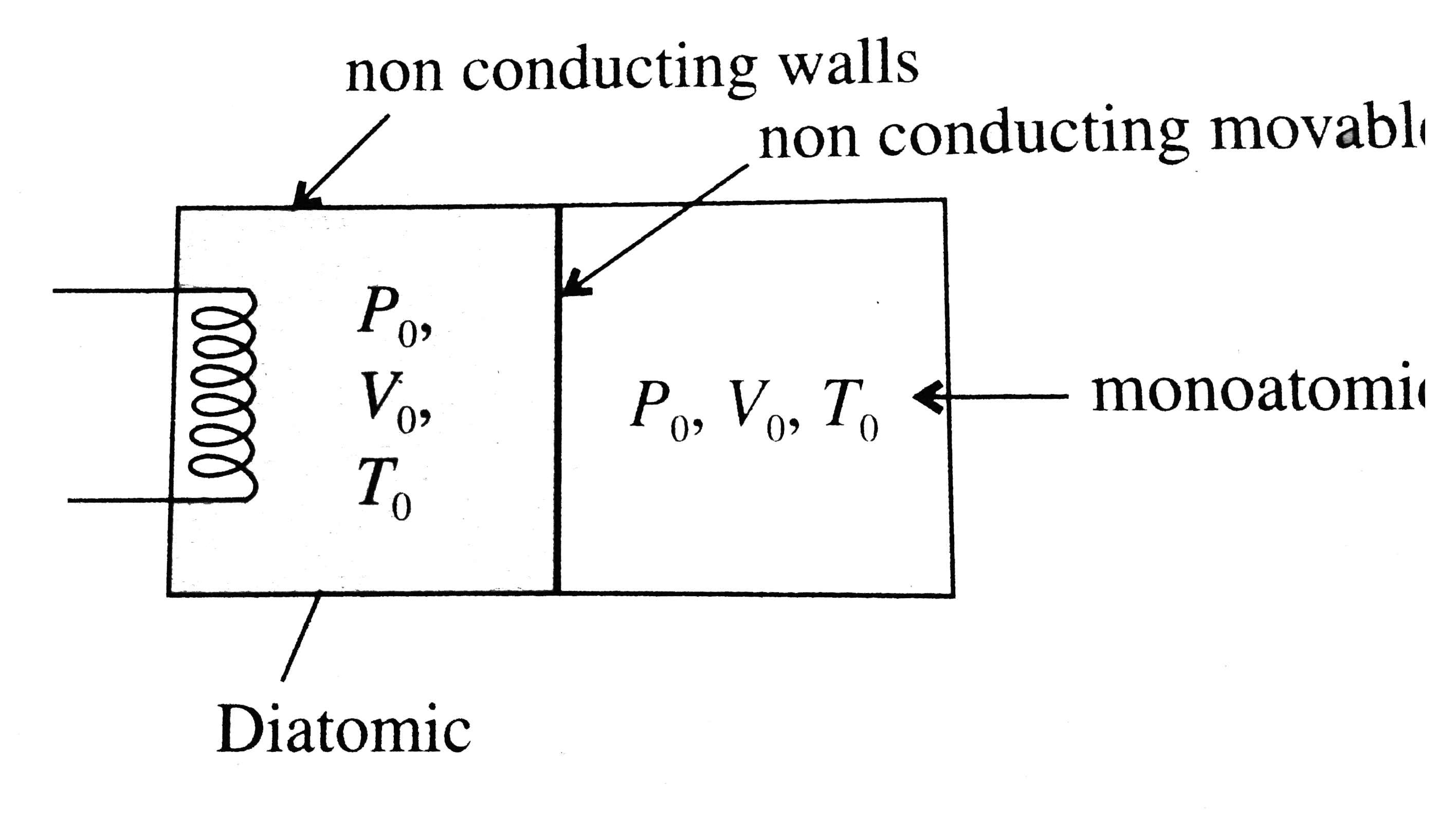 04:41View Solution
04:41View SolutionA non-conducting cylinder having volume 2V0 is partitioned by a fixed non conducting wall in two equal part. Partition is attached with a valve. Right side of the partition is a vacuum and left part is filled with a gas having pressure and temperature P0 and T0 respectively. If valve is opened find the final pressure and temperature of the two parts.
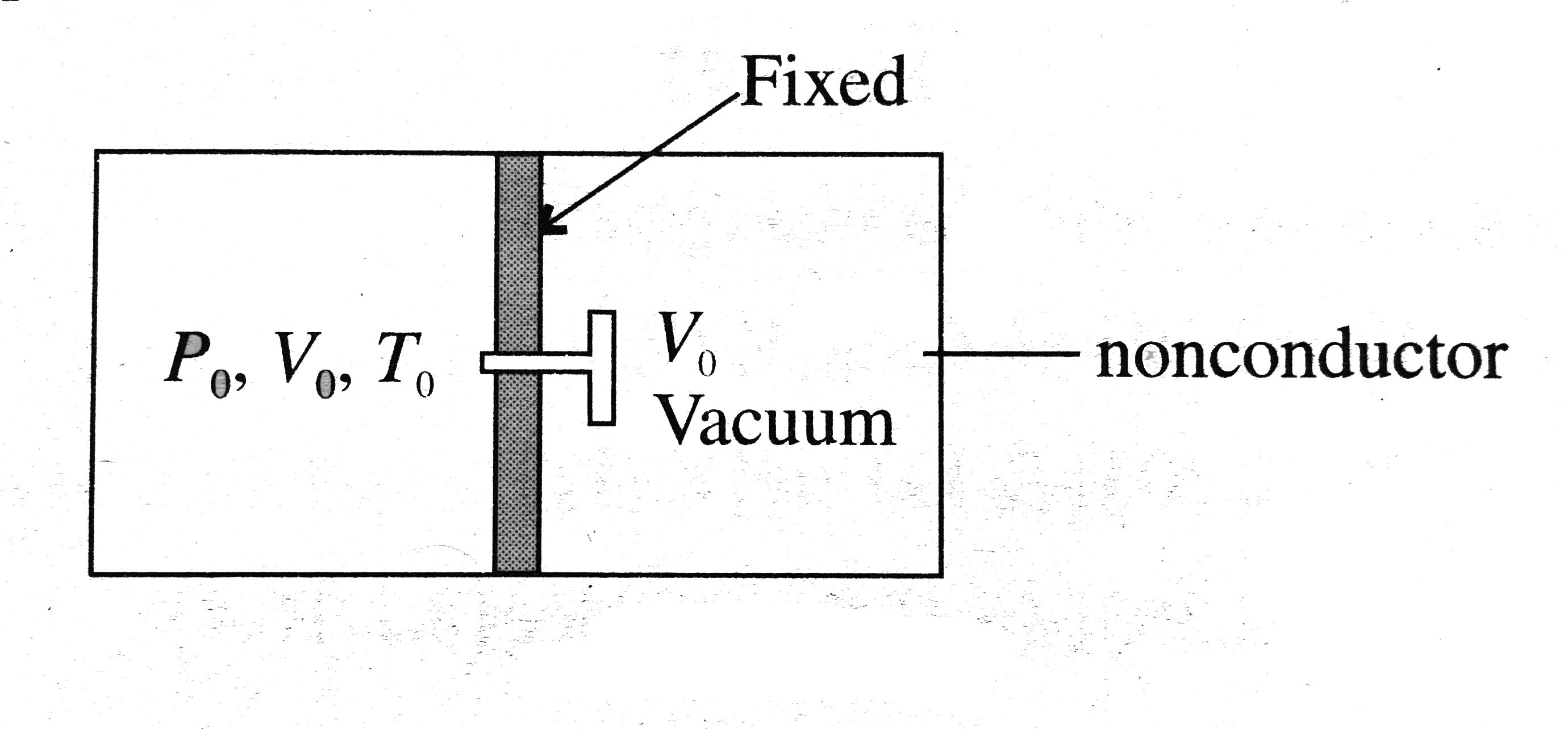 13:53View Solution
13:53View SolutionA container of volume 4V0 made of a perfectly non− conducting material is divided into two equal parts by a fixed rigid wall whose lower half is non− conducting and upper half is purely conducting. The right side of the wall is divided into equal parts ( initially 0 by means of a massless non− conducting piston free to move as shown . SectionA constains 2mol of a gas while the section B and C contain 1mol each of the same gas (γ=15.) at pressure P0 . The heater in left part is switched on till the final pressure in section C becomes 125/27P0. Calculate

Final temperature in part C.08:57View SolutionA container of volume 4V_(0) made of a perfectly non - conducting material is divided into two equal parts by a fixed rigid wall whose lower half is non - conducting and upper half is purely conducting. The right side of the wall is divided into equal parts ( initially 0 by means of a massless non - conducting piston free to move as shown . Section A constains 2 mol of a gas while the section B and C contain 1 mol each of the same gas ( gamma = 15. ) at pressure P_(0) . The heater in left part is switched on till the final pressure in section C becomes 125//27 P_(0) . Calculate The heat supplied by the heater.
04:42View Solution

